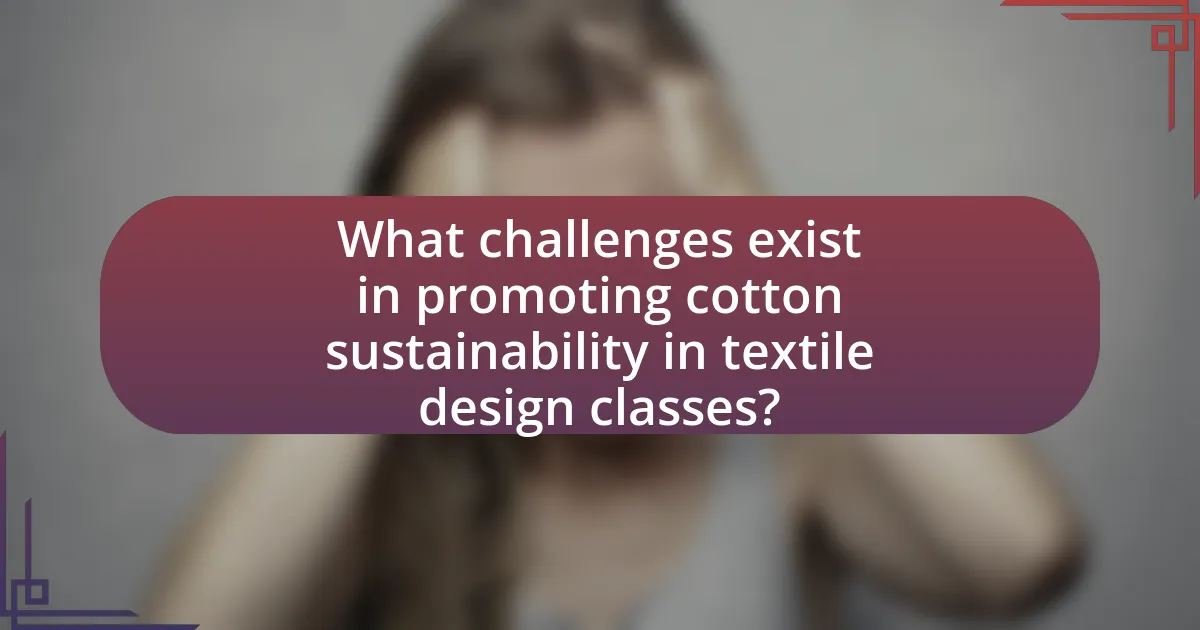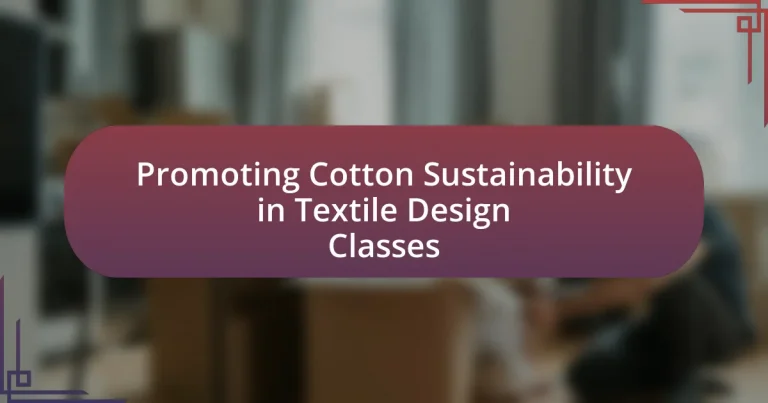Promoting cotton sustainability in textile design classes focuses on integrating sustainable practices related to cotton production into educational curricula. This approach highlights the environmental impacts of conventional cotton farming, such as excessive water usage and pesticide application, while advocating for sustainable alternatives like organic cotton and regenerative agriculture. Key principles include responsible water management, reduced pesticide use, and fair labor practices, which collectively contribute to a more sustainable textile industry. The article discusses the importance of hands-on projects, collaboration with industry partners, and effective teaching methods to enhance student understanding and commitment to sustainability in textile design. Additionally, it addresses challenges and misconceptions surrounding cotton sustainability, offering strategies for educators to foster a culture of sustainability in their classrooms.

What is Promoting Cotton Sustainability in Textile Design Classes?
Promoting cotton sustainability in textile design classes involves integrating sustainable practices and principles related to cotton production and usage into the curriculum. This approach educates students about the environmental impacts of cotton farming, such as water consumption and pesticide use, while highlighting sustainable alternatives like organic cotton and regenerative agriculture. Research indicates that sustainable cotton farming can reduce water usage by up to 90% compared to conventional methods, making it a crucial topic in textile education. By incorporating these elements, textile design programs aim to prepare future designers to make informed choices that support environmental sustainability in the fashion industry.
Why is cotton sustainability important in textile design education?
Cotton sustainability is important in textile design education because it directly impacts environmental conservation and social responsibility within the industry. Educating future designers about sustainable cotton practices fosters awareness of the ecological footprint associated with cotton production, which includes significant water usage and pesticide application. According to the World Wildlife Fund, conventional cotton farming consumes approximately 2.6% of the world’s water supply, highlighting the need for sustainable alternatives. By integrating sustainability into textile design curricula, students learn to prioritize eco-friendly materials and practices, ultimately contributing to a more sustainable fashion industry.
What are the environmental impacts of cotton production?
Cotton production has significant environmental impacts, primarily due to its high water consumption, pesticide use, and land degradation. The cultivation of cotton requires approximately 7,000 liters of water to produce just one kilogram of cotton, leading to water scarcity in many regions. Additionally, conventional cotton farming relies heavily on pesticides, with about 16% of global insecticides and 6% of global herbicides used in its production, which can harm biodiversity and contaminate water sources. Furthermore, the conversion of natural habitats into cotton fields contributes to soil erosion and loss of biodiversity, as well as greenhouse gas emissions from land-use changes. These factors collectively highlight the urgent need for sustainable practices in cotton production to mitigate its environmental footprint.
How does sustainable cotton contribute to the textile industry?
Sustainable cotton significantly contributes to the textile industry by reducing environmental impact and promoting ethical practices. This type of cotton is grown using methods that minimize water usage, avoid harmful pesticides, and enhance soil health, leading to a lower carbon footprint compared to conventional cotton farming. For instance, according to the Textile Exchange’s 2021 report, organic cotton farming uses 91% less water than conventional methods, which highlights its sustainability benefits. Furthermore, sustainable cotton supports fair labor practices, ensuring that farmers receive fair wages and work in safe conditions, thereby fostering social responsibility within the industry.
What are the key principles of cotton sustainability?
The key principles of cotton sustainability include responsible water management, reduced pesticide use, soil health improvement, and fair labor practices. Responsible water management focuses on minimizing water consumption and utilizing efficient irrigation techniques, as cotton cultivation can be water-intensive. Reduced pesticide use emphasizes integrated pest management strategies to lower chemical dependency, which can harm ecosystems. Soil health improvement involves practices like crop rotation and organic farming to enhance soil fertility and biodiversity. Fair labor practices ensure that workers in the cotton industry receive equitable treatment and compensation, promoting social sustainability. These principles collectively contribute to a more sustainable cotton production system, addressing environmental, economic, and social dimensions.
How can sustainable practices be integrated into textile design curricula?
Sustainable practices can be integrated into textile design curricula by incorporating modules that focus on eco-friendly materials, production processes, and lifecycle assessments. For instance, educators can introduce courses that emphasize the use of organic cotton and other sustainable fibers, highlighting their environmental benefits compared to conventional materials. Additionally, practical projects can be designed to encourage students to create textiles using sustainable methods, such as low-impact dyeing techniques and waste reduction strategies. Research indicates that integrating sustainability into design education not only enhances students’ awareness but also prepares them for industry demands, as the global market increasingly prioritizes sustainable practices.
What role do educators play in promoting cotton sustainability?
Educators play a crucial role in promoting cotton sustainability by integrating sustainable practices and knowledge into their curriculum. They educate students about the environmental impacts of cotton production, including water usage and pesticide application, and encourage the adoption of sustainable farming techniques. For instance, educators can highlight the benefits of organic cotton farming, which reduces chemical inputs and promotes biodiversity. Research indicates that educational programs focused on sustainability can significantly influence students’ attitudes and behaviors towards eco-friendly practices, fostering a new generation of designers committed to sustainable textile practices.

How can textile design classes effectively promote cotton sustainability?
Textile design classes can effectively promote cotton sustainability by integrating sustainable practices and education into their curriculum. By teaching students about organic cotton farming, water conservation techniques, and the environmental impact of conventional cotton production, these classes can raise awareness and encourage responsible sourcing. Research indicates that organic cotton farming uses 91% less water than conventional methods, highlighting the importance of sustainable practices in reducing environmental strain. Additionally, incorporating hands-on projects that utilize sustainable materials and promote eco-friendly design principles can further instill a commitment to sustainability among future designers.
What teaching methods can be used to educate students about cotton sustainability?
Interactive learning methods, such as project-based learning and hands-on workshops, can effectively educate students about cotton sustainability. These methods engage students in real-world applications, allowing them to explore sustainable practices in cotton production and textile design. For instance, students can participate in projects that involve researching sustainable cotton farming techniques or creating designs using organic cotton. Research indicates that experiential learning enhances retention and understanding, making it a powerful approach in teaching sustainability concepts. Additionally, incorporating case studies of sustainable cotton brands can provide concrete examples of successful practices, further reinforcing the importance of sustainability in the textile industry.
How can hands-on projects enhance understanding of sustainable practices?
Hands-on projects enhance understanding of sustainable practices by providing practical experience that reinforces theoretical knowledge. Engaging in activities such as creating textiles from organic cotton allows students to directly observe the environmental impact of their choices, such as water usage and chemical inputs. Research indicates that experiential learning increases retention of information; for instance, a study published in the Journal of Environmental Education found that students involved in hands-on sustainability projects demonstrated a 30% increase in knowledge retention compared to traditional learning methods. This direct involvement fosters a deeper appreciation for sustainable practices, as students can see the tangible outcomes of their efforts and the importance of sustainability in textile design.
What resources are available for educators to teach about cotton sustainability?
Educators can access a variety of resources to teach about cotton sustainability, including online platforms, educational toolkits, and research publications. For instance, the Better Cotton Initiative provides comprehensive educational materials that cover sustainable cotton farming practices and their environmental impacts. Additionally, the Cotton Incorporated’s “Cotton Sustainability” webpage offers lesson plans, videos, and infographics that illustrate sustainable practices in the cotton industry. Research studies, such as “Sustainable Cotton Production: A Review” published in the Journal of Cleaner Production, provide empirical data and case studies that can enhance classroom discussions. These resources collectively equip educators with the necessary tools to effectively teach about the sustainability of cotton.
How can collaboration with industry partners enhance sustainability education?
Collaboration with industry partners enhances sustainability education by providing real-world insights and practical applications of sustainable practices. When educational institutions partner with industry leaders in the textile sector, such as cotton producers and sustainable fashion brands, students gain access to current technologies, materials, and methodologies that are actively being used in the field. For instance, partnerships can facilitate workshops, internships, and projects that allow students to engage directly with sustainable practices, such as organic cotton farming or eco-friendly dyeing processes. This experiential learning not only deepens students’ understanding of sustainability but also prepares them for careers in a rapidly evolving industry that increasingly prioritizes environmental responsibility.
What benefits do partnerships with sustainable cotton producers offer to students?
Partnerships with sustainable cotton producers offer students practical experience in sustainable practices and enhance their understanding of ethical sourcing in the textile industry. By collaborating with these producers, students gain firsthand knowledge of sustainable farming techniques, which can inform their design choices and promote environmentally responsible practices. Additionally, such partnerships often provide access to high-quality materials that align with sustainability goals, allowing students to create innovative designs while minimizing environmental impact. This experiential learning fosters critical thinking about sustainability issues and prepares students for careers in a growing market that values eco-friendly practices.
How can guest speakers from the industry influence student perspectives?
Guest speakers from the industry can significantly influence student perspectives by providing real-world insights and experiences that enhance academic learning. Their firsthand accounts of industry practices, challenges, and innovations in cotton sustainability can bridge the gap between theoretical knowledge and practical application. For instance, when a guest speaker shares specific case studies of sustainable cotton sourcing or innovative textile design techniques, students gain a clearer understanding of the complexities involved in the industry. This exposure not only enriches their learning experience but also inspires them to think critically about sustainability issues in textile design, fostering a more informed and engaged mindset towards their future careers.

What challenges exist in promoting cotton sustainability in textile design classes?
Promoting cotton sustainability in textile design classes faces several challenges, including limited awareness of sustainable practices among students and educators. Many textile design curricula do not prioritize sustainability, resulting in a lack of knowledge about the environmental impacts of cotton production. Additionally, the cost of sustainable cotton materials can be higher than conventional options, discouraging their use in projects. Furthermore, there is often a disconnect between theoretical knowledge and practical application, making it difficult for students to implement sustainable practices effectively. These challenges hinder the integration of sustainability into textile design education, limiting the potential for future industry change.
What are the common misconceptions about cotton sustainability?
Common misconceptions about cotton sustainability include the belief that all cotton is environmentally harmful and that organic cotton is always the best choice. While conventional cotton farming can involve high pesticide use, sustainable practices are increasingly adopted, reducing environmental impact. Additionally, organic cotton, while beneficial, may not always be the most sustainable option due to factors like water usage and land requirements. According to the Textile Exchange’s 2021 report, sustainable cotton initiatives, including Better Cotton and organic practices, are gaining traction, showing that not all cotton is created equal and that sustainable practices can significantly mitigate environmental harm.
How can educators address these misconceptions in their teaching?
Educators can address misconceptions about cotton sustainability in textile design classes by incorporating evidence-based practices and real-world examples into their curriculum. For instance, they can utilize case studies that highlight successful sustainable cotton farming practices, such as organic cotton production, which has been shown to reduce environmental impact by using fewer pesticides and promoting biodiversity. Additionally, educators can engage students in hands-on projects that involve sourcing sustainable materials, thereby reinforcing the importance of ethical decision-making in textile design. Research indicates that experiential learning significantly enhances understanding and retention of complex concepts, making it an effective strategy for dispelling misconceptions.
What barriers do educators face in implementing sustainable practices?
Educators face several barriers in implementing sustainable practices, including lack of resources, insufficient training, and institutional resistance. Limited funding restricts access to sustainable materials and technologies, making it difficult for educators to incorporate these practices into their curriculum. Additionally, many educators report feeling unprepared to teach sustainability due to inadequate professional development opportunities, which hinders their ability to effectively convey sustainable practices to students. Institutional resistance often arises from existing curricula that prioritize traditional methods over innovative, sustainable approaches, creating a challenge for educators who wish to integrate sustainability into their teaching.
How can students be motivated to embrace sustainable practices?
Students can be motivated to embrace sustainable practices by integrating hands-on projects that focus on sustainability within their curriculum. Engaging students in practical applications, such as designing textile products using organic cotton or recycled materials, fosters a deeper understanding of sustainable practices. Research indicates that experiential learning enhances student engagement and retention of knowledge, as demonstrated in studies like “The Impact of Experiential Learning on Student Engagement” by Kolb and Kolb, which highlights that active participation leads to greater commitment to sustainability. Additionally, incorporating discussions on the environmental impact of textile production can further inspire students to adopt sustainable practices in their design work.
What incentives can be offered to encourage student engagement in sustainability initiatives?
Incentives that can be offered to encourage student engagement in sustainability initiatives include academic credit, financial rewards, and recognition programs. Academic credit can motivate students to participate in sustainability projects as it directly contributes to their educational goals. Financial rewards, such as scholarships or grants for sustainable projects, can provide tangible benefits that encourage involvement. Recognition programs, like awards or certificates for outstanding contributions to sustainability, can enhance students’ resumes and foster a sense of accomplishment. Research indicates that these incentives effectively increase student participation in sustainability initiatives, as evidenced by programs at various universities that have reported higher engagement levels when such incentives are implemented.
How can student-led projects foster a culture of sustainability in design classes?
Student-led projects can foster a culture of sustainability in design classes by actively engaging students in hands-on experiences that emphasize eco-friendly practices. These projects encourage collaboration and innovation, allowing students to explore sustainable materials, such as organic cotton, and design processes that minimize environmental impact. Research shows that experiential learning, such as that found in student-led initiatives, significantly enhances students’ understanding of sustainability concepts and their application in real-world scenarios. For instance, a study published in the Journal of Cleaner Production found that students involved in sustainability-focused projects reported a greater commitment to sustainable practices in their future careers. This direct involvement not only cultivates a sense of responsibility but also empowers students to advocate for sustainable design principles within their communities.
What are the best practices for integrating cotton sustainability into textile design education?
The best practices for integrating cotton sustainability into textile design education include incorporating hands-on projects that utilize sustainable cotton materials, teaching the environmental impact of cotton production, and collaborating with industry experts to provide real-world insights. Hands-on projects allow students to engage directly with sustainable practices, fostering a deeper understanding of the material’s lifecycle. Educators should emphasize the environmental challenges associated with conventional cotton farming, such as water usage and pesticide application, to highlight the importance of sustainable alternatives. Collaborating with industry experts can provide students with current trends and innovations in sustainable cotton practices, ensuring that the education provided is relevant and applicable to the evolving textile industry.
How can educators assess the effectiveness of sustainability initiatives in their classes?
Educators can assess the effectiveness of sustainability initiatives in their classes by implementing pre- and post-assessments that measure students’ knowledge and attitudes towards sustainability. These assessments can include surveys, quizzes, and reflective essays that evaluate changes in understanding and behavior regarding sustainable practices. For instance, a study published in the Journal of Cleaner Production found that students who participated in sustainability-focused projects showed a significant increase in their awareness and commitment to sustainable practices, indicating that such initiatives can lead to measurable educational outcomes.
What strategies can be employed to continuously improve sustainability education?
To continuously improve sustainability education, integrating experiential learning opportunities is essential. This approach allows students to engage in hands-on projects that emphasize sustainable practices, such as using organic cotton in textile design. Research indicates that experiential learning enhances retention and application of knowledge, as demonstrated in studies like “The Impact of Experiential Learning on Student Engagement” by Kolb and Fry, which highlights improved understanding through practical application. Additionally, incorporating interdisciplinary collaboration fosters a broader perspective on sustainability, as seen in programs that combine design, environmental science, and social responsibility. This strategy not only enriches the educational experience but also prepares students to address complex sustainability challenges in their future careers.





